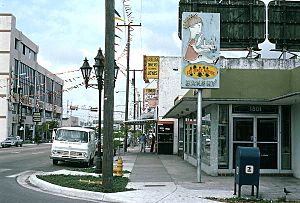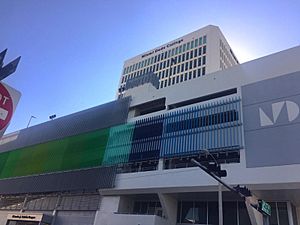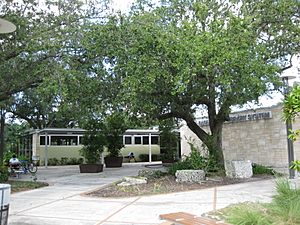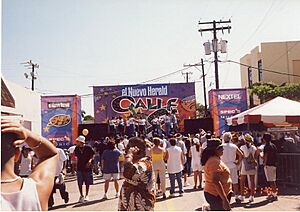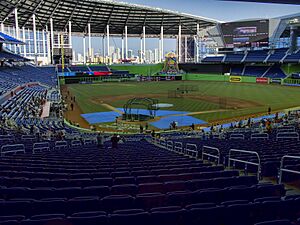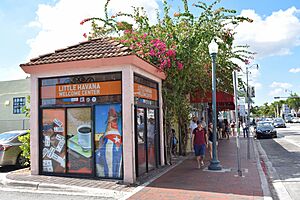Little Havana facts for kids
Quick facts for kids
Little Havana
Pequeña Habana
|
||
|---|---|---|
|
Neighborhood of Miami
|
||

Little Havana's Domino Park on Calle Ocho
|
||
|
||

Little Havana neighborhood within the city of Miami
|
||
| Country | United States | |
| State | Florida | |
| County | Miami-Dade | |
| City | Miami | |
| Population
(2010)
|
||
| • Total | 76,163 | |
| • Density | 21,815/sq mi (8,423/km2) | |
| Time zone | UTC-05 (EST) | |
| ZIP Code |
33125, 33126, 33128, 33130, 33135
|
|
| Area code(s) | 305, 786 | |
Little Havana (which means Pequeña Habana in Spanish) is a lively neighborhood in Miami, Florida, United States. It is famous for being home to many people who came from Cuba. It also welcomes immigrants from Central and South American countries. The neighborhood gets its name from Havana, the capital city of Cuba.
Little Havana is a hub for social, cultural, and political activities in Miami. Its popular festivals, like the Calle Ocho Festival and Viernes Culturales (Cultural Fridays), are watched by millions worldwide. The neighborhood also has famous landmarks. These include Calle Ocho (SW 8th Street), which is a main street, and its Walk of Fame. This Walk of Fame honors famous Latin artists and personalities like Celia Cruz and Gloria Estefan. Other important spots are the Cuban Memorial Boulevard and Domino Park.
This neighborhood is known around the world as the most famous Cuban community outside of Cuba. It is special for its busy streets, delicious restaurants, and vibrant music. It also has many small businesses and a strong sense of community among its residents. In 2015, Little Havana was listed as one of the 11 Most Endangered Places in the U.S. However, in 2017, it was declared a national treasure.
Contents
History of Little Havana
How Little Havana Began
Little Havana was once a neighborhood for middle-class Southern families and a growing Jewish community in the 1930s. The area changed in the 1960s when many Cubans moved there. Today, "Little Havana" is the area just west of Downtown Miami. It stretches about two and a half miles from the Miami River. This name was given to the Shenandoah and Riverside areas in the 1960s. This happened after many Cuban refugees started arriving. Little Havana is now known as the cultural and political center for Cuban Americans. It is a key place for the Cuban exile community.
Growing Cuban Community
In the 1960s, many Cubans left Cuba to escape the government. This made the area a center for people who were against the Cuban government. The new residents hoped their stay in Miami would be short. They believed Castro would soon be removed from power. By 1970, over 85% of the neighborhood's residents were Cuban. Since Castro remained in power, Cuban Americans began to settle permanently in Miami. Little Havana stayed the main place for new immigrants and a strong base for Cuban-owned businesses.
Who Lives in Little Havana Today?
As of 2011, Little Havana has the highest number of Hispanic people in Miami, making up 98% of its population. While Cubans are still a big part of the community, their numbers have decreased. In 1979, 84% of the Hispanic population was Cuban. By 1989, this dropped to 58%. More people from other Central American countries, like Nicaragua and Honduras, have moved in since the late 1990s. Even with this mix of cultures, most businesses in the neighborhood are still owned by Cubans.
Exploring Little Havana's Borders
- Western Border: Southwest 37th Avenue
- Eastern Border: Southwest 3rd Avenue
- Northern Border: Northwest 7th Street
- Southern Border: Southwest 22nd Street (Coral Way)
People and Population
In 2000, Little Havana had 49,206 residents. Most of the people living there were Hispanic or Latino (85.08%). This group mainly included Cubans, but also many Nicaraguans and Honduran Americans. Other groups included Black or African American people (3.79%) and Non-Hispanic White people (10.14%).
Historic Places and Districts
South River Drive Historic District
|
South River Drive Historic District
|
|
 |
|
| Lua error in Module:Location_map at line 420: attempt to index field 'wikibase' (a nil value). | |
| Location | Little Havana, Miami, Florida |
|---|---|
| Area | 25 acres (100,000 m2) |
| NRHP reference No. | 87000671 |
| Added to NRHP | August 10, 1987 |
The South River Drive Historic District is a special area in Little Havana. It was named a historic district by Miami City in 1987. Later that year, it was added to the National Register of Historic Places. This district is located along the Miami River, just west of Downtown Miami. It includes nine historic buildings.
This district is important for its architecture and history. It has some of the city's oldest buildings from the early 1900s. These buildings show a simple, local style of architecture.
Riverview Historic District
The Riverview Historic District was named a historic district by the City of Miami in 2015. It is located west of Downtown Miami, within the Little Havana neighborhood. This district features homes and businesses. They are built in styles like Bungalow, Mission, Mediterranean Revival, and Miami Modern.
Viernes Culturales: Cultural Fridays
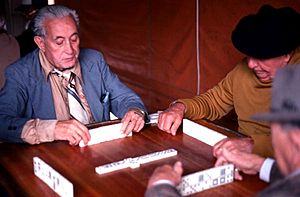
Viernes Culturales, or Cultural Fridays, is a fun arts and culture fair. It happens on the last Friday of every month. You can find it in the historic Little Havana neighborhood of Miami. The event takes place on Calle Ocho (8th St. SW between 14th and 17th Avenues).
During the event, you can enjoy live music outdoors. There are also art exhibits along the sidewalks and in open spaces. You can visit art galleries and cultural centers. Many restaurants offer food tastings. The historic Tower Theater shows films, art, and educational programs. Free walking tours are also available. They start from the Tower Theater at 7 PM on festival days.
Places of Worship
Little Havana is home to many churches and religious centers. These include:
- St. John Bosco Catholic Church
- Holy Comforter Episcopal Church
- Ermita De Regla, Miami
- St. Michael the Archangel Catholic Church
- St. Raymond of Peñafort Catholic Church
Parks and Green Spaces
The neighborhood has several parks where people can relax and play:
- Máximo Gómez Park (also known as Domino Park), on Calle Ocho
- Plaza de la Cubanidad
- Cuban Memorial Boulevard Park (SW 13th Avenue)
- Jose Marti Park
- Shenandoah Park
Education in Little Havana
Miami-Dade County Public Schools manages the public schools in the area. Here are some of the schools in Little Havana:
Public Schools
Elementary Schools
- Citrus Grove Elementary School
- Riverside Elementary School
- Shenandoah Elementary School
- Ada Merritt K-8 Center
Middle Schools
- Citrus Grove Middle School
- Shenandoah Middle School
- Ada Merritt K-8 Center
- International Studies Charter School
High Schools
- Miami Senior High School, founded in 1903 (Miami's oldest high school)
- Young Women's Preparatory Academy (an all-girls school)
- International Studies Charter School
Colleges
- Miami Dade College- Eduardo Padrón Campus
Libraries
The Miami-Dade Public Library system runs the public libraries in the area:
- Hispanic Library
- Shenandoah Library
Cultural Spots
Little Havana has many places that celebrate different cultures:
- L'Alliance Française de Miami, for French language and culture.
- La Società Dante Alighieri, for Italian language and culture.
Museums and Memorials
- Bay of Pigs Museum and Library
- Bay of Pigs Monument
- Cuban Memorial Boulevard Park (SW 13th Avenue)
- Freedom Tower
Theaters and Performance Arts
You can enjoy plays and performances at these theaters:
- Tower Theatre, 1508 SW 8th St
- Manuel Artime Theatre, 900 SW 1st St
- Miami-Dade County Auditorium, 2901 W Flagler St
- Teatro 8, 2101 SW 8th St
Calle Ocho Festival
Little Havana hosts its yearly Calle Ocho street festival. This event is part of the larger Carnaval Miami celebration. It is one of the biggest festivals in the world, attracting over one million visitors. The Kiwanis Club of Little Havana sponsors this free street festival, which has a fun Caribbean carnival feel.
At Calle Ocho, people from different backgrounds wear colors or flags to show pride in their heritage. You can see flags from Colombia, Nicaragua, Puerto Rico, Costa Rica, and even Ireland. Foods from many countries are available to buy. Popular Latin music like reggaeton, salsa, bachata, and merengue fills the air.
The festival takes place on Southwest 8th Street, between 27th Avenue and 4th Avenue. Over 30 stages and hundreds of street vendors take part in this live music festival. It has been going on for over 40 years. Calle Ocho even made it into the Guinness Book of World Records. On March 13, 1988, 119,986 people formed the world's longest conga line. In 2010, Florida's government officially named the Calle Ocho-Open House 8 festival as the state's official festival.
Cool Places to Visit
When you visit Little Havana, check out these spots:
- Calle Ocho (SW 8th Street)
- Cuban Memorial Boulevard (SW 13th Avenue)
- Little Havana Visitors Center (1600 SW 10 Street)
- Versailles Restaurant (SW 8 Street and 36 Avenue)
- LoanDepot Park (where the old Orange Bowl stadium used to be)
- Calle Ocho Walk of Fame (SW 8th Street between SW 12th Avenue and SW 17th Avenue)
- Ball & Chain (1513 SW 8 Street), a famous live music bar that opened in 1935.
Images for kids
-
An aerial view of Little Havana. The Miami River is in the front. Marlins Park is to the right. The skyline of Coral Gables is in the background. Coconut Grove and Biscayne Bay are on the far left.
See also
 In Spanish: Pequeña Habana para niños
In Spanish: Pequeña Habana para niños



